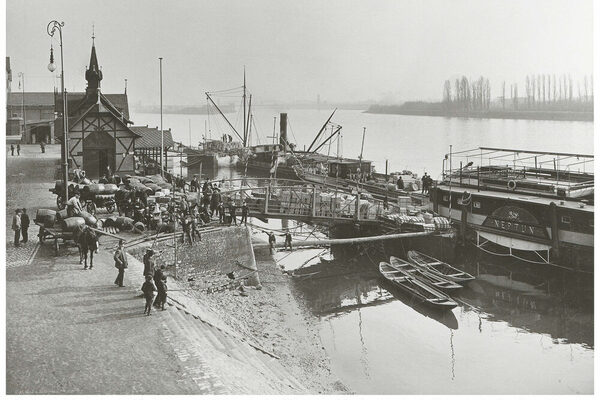Biebrich jetty
The first written reference to Biebrich in 874 already mentions a landing stage for ships. Even then, it can be assumed that there was constant ferry traffic, with the help of which the Rhine could be crossed. The crossing was first mentioned in writing in 1302. In 1336, Emperor Ludwig the Bavarian granted Count Gerlach zu Nassau and his heirs ferry rights to Biebrich for all time. From then on, the Biebrich Rhine ferry belonged to the imperial fiefdoms of the Counts and Princes of Nassau. The ferries were the regular connection between Wiesbaden and Mainz. In 1563 there were six ferrymen in Biebrich.
Until 1798, shipping traffic on the Rhine took place exclusively on the left bank via Mainz. Only a very small number of market ships that sailed from Mainz to the riverside towns of the Rheingau also touched Biebrich. Biebrich remained untouched by the new age of steam navigation from 1826, as the ships sailed upstream and downstream on the other side of the Rhine. Travelers to Wiesbaden had to travel to Mainz, cross the ship's bridge to Kastel and be transported from there to Wiesbaden. It was not until Article 10 of the Rhine Navigation Act of 31.03.1831 that Biebrich was declared a Rhine port. Transit traffic on the Rhine now shifted to the right bank of the Rhine.
As a result of this new situation, the "Kölnische", the "Düsseldorfer" and the "Niederländische Dampfschifffahrtsgesellschaft" built their own landing stages in 1832, 1838 and 1839, initially in front of Biebrich Castle. In 1848, these were moved in the direction of Biebrich. With the Rhine Navigation Act of 1831, Biebrich was declared a Rhine port with free storage of goods and thus also a transshipment point for goods for Frankfurt and Wiesbaden. This impaired the function of Mainz, while Biebrich's importance as the "pre-port of Frankfurt" increased even more after the Duchy of Nassau joined the German Customs Union in 1836.
As a result of the growing trade traffic, the ducal government decided to move the main tax office from Höchst to Biebrich in 1839. A further increase in passenger and goods traffic was brought about by the completion of the Wiesbaden-Frankfurt Taunus Railway in 1840 with a branch from Curve station to the Biebrich Rhine railway station in 1838. In 1841, this led to the so-called Mainz Fog Boy's Prank, a river barricade that blocked access to the Biebrich harbour. Only after much diplomatic back and forth was the obstacle removed and the entrance and exit to Biebrich harbor reopened. In 1849, the customs building on the banks of the Rhine was equipped with large cellars and warehouses and handed over for its intended purpose. At the same time, the last part of the Biebrich Rhine quay was completed.
In the following years, shipping traffic at Biebrich harbor experienced an enormous upswing. In 1909/10, 316,788 people were transported by the Cologne-Düsseldorfer and Dutch ships, and 63,389 by the local steamers. The number of passenger boats that arrived was 3,742, the number of goods boats 1,264 with a total goods weight of 86,000 tons. The Biebrich customs office, whose function was initially expanded after the Second World War with the construction of a customs tower, saw lively goods traffic until the 1970s.
Today, shipping traffic is limited to passenger shipping. In the summer months, the Cologne-Düsseldorf passenger ships sail daily from Biebrich down the Rhine to Cologne. A Frankfurt shipping line offers trips on the Rhine in summer. A local boat serves the campsite on the Rettbergsaue and the Schierstein lido.
Literature
Kraus, Georg: From Biebrich's history. VI Shipping. In: Nassovia. Zeitschrift für nassauische Geschichte und Heimatkunde, Bad Homburg 1912 [pp. 229-231].
